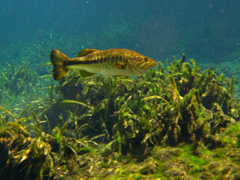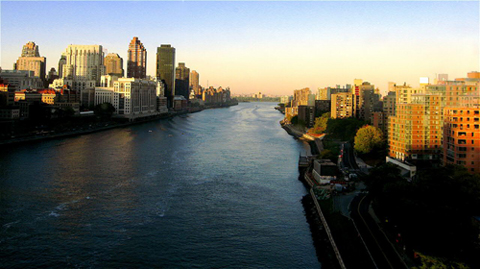What Alternative Energy Taught Us About the Fish that Live in the East River
Lesson 1: There are fish that live in the East River
Sure, New York City’s East River has long been a punchline for jokes about industrial pollution and mafia homicide, but it’s far from being a dead zone. That stereotype is one of Jonathan Colby’s biggest pet peeves. There are many species of fish living below the water, he says, and diving birds, such as cormorants, that live above. You can even watch the cormorants—big, jet-black creatures with yellow beaks—doing their thing from the promenade along the Eastern edge of Roosevelt Island.
The River really was once in trouble, but it’s rebounded in a big way since the 1980s. It’s just that, until recently, Colby says, nobody had documented the results that successful clean up had on fish populations.
The impetus behind the East River’s first wildlife study in decades: Hydroelectricity. Colby is a hydrodynamic engineer with Verdant Power, a company that’s working on installing 1 megawatt of electric generation in the East River, using a system of spinning blades on posts—similar to wind turbines. To make sure the fish don’t hit the fan, Colby had to document a baseline population and then monitor fish numbers and behavior over two years, while Verdant ran a 185-kilowatt demonstration project.
Monitoring happened round-the-clock, 24-7, using both traditional sonar and a new system called Dual Frequency Identification Sonar, or DIDSON. While basic sonar tells you that an object is in the water, DIDSON can show you what the object is—whether fish or plastic bag. The images produced by DIDSON look a lot like fetal ultrasound pictures. Suffice to say, the results might look a little abstract to you or me, but experienced analysts can get at least an Impressionist level of information out of it, including the direction the fish are traveling and, in some cases, what kind of fish are out there.
“There are like 1000 fish, per month, that just kind of live here [in the area surrounding Verdant’s turbines] during the non-migratory period,” Colby said. “During migratory periods, you can see upwards of 10,000 fish per month traveling through these waters.”
 Lesson 2: Some fish are local, some commute
Lesson 2: Some fish are local, some commute
The misleadingly named East River is actually a tidal estuary connecting Upper New York Bay to Long Island Sound. Colby’s research found that this short-cut around Long Island is a major channel for two annual fish migrations—a caravan of small fish in late Fall, followed by all the big fish in early Winter.
“What it really looks like is that these small fish pick up on changes in water temperature and then they start to move, and all of a sudden the larger fish are like, ‘Damn, where did all of our food go?’” Colby said. “All of this is new. No one knew this about the East River.”
What launches the little fish? Colby’s theory, recently presented to the New York State Regulators, is that the first wave decides to move based on temperature changes and lunar keys. Fish know when it’s getting colder, and they can sense whether the tides are fast or slow, he says. Fish wait to move until the tide is right.
Lesson 3: Fish won’t blend
Amazingly, neither local fish, nor the bridge-and-tunnel crowd, were harmed during Verdant Power’s two-year demonstration project. The independent analysts who poured over all that data collected by the sonar and DIDSON never saw a single fish struck by a turbine blade. That’s a big deal, but it has less to do with any skillful planning by Verdant, than with normal fish behavior.
The local fish avoided being clonked on the noggin—the blades don’t turn fast enough to make puree a real concern—thanks to tidal cycles. The East River flows one direction during the day, and the other at night. In between, there’s a slow zone, when the speed of the current drops significantly. For several hours every day, it’s too slow for the turbines to spin.
Conveniently, that’s also when the local fish are most active, taking advantage of the still waters to do their feeding with less of a physical workout. The rest of the time, they mostly just hang out, hiding in rocks along the river’s edge.
Migrating fish, on the other hand, don’t slow down and take in the sights. Like tourists who accidentally wandered into a sketchy neighborhood, they speed through the East River, heading for more familiar territory. But they don’t seem to hit the turbines, either. Why? Because the turbines don’t completely fill the river, and the fish aren’t stupid. As far as anyone can tell, migrating fish just swim around.
“It makes so much sense though,” Colby said. “Because, bridge piers. Fish can sense them coming up and they don’t just run into bridge piers. Literally, our turbines are sending out an acoustic pressure wave that fish can sense up and down the river.”

Guest Blogger Profile: MAGGIE KOERTH-BAKER is a freelance science journalist and the science editor at BoingBoing.net. She’s currently writing a book for Wiley & Sons about the future of energy in the United States.

Loved the post, thanks!
joyful news — life WILL find a way (Jurassis Park)! thanks.
[…] What Alternative Energy Taught Us About the Fish that Live in the East River | PLoS Blogs Network. […]
oh man! awesome! glad to see some full circle on this too – i remember when they got hit with the “but you have to do studies on the impacts of local life” and they were like “what local life?” and as soon as they got cameras down there, they saw fish, and saw fish swimming past these lumbering turbine blades, as any land-faring creature might avoid a branch, log, bush, lightpost or otherwise. glad to see that not only is there (somewhat) abundant life, but that the turbines dont impact life (enough) to halt installation of what i think was a string of turbines, and a great boon to “green” energy initiatives.
Fascinating article, thanks for posting!
[…] got a guest post up at the Public Library of Science blogs […]
[…] new buddy Kevin Seccia, who is the older brother of one of my oldest friends Heather, pointed me to this link today about a study conducted for a hydroelectric power company concerning the fish population in […]
[…] study of the impacts of the tidal turbines on a surprising abundance of East River fish, analysts did not see a single instance of a fish being struck by a rotating blade. It turns out that the larger migrating fish simply avoid the blades, and […]
[…] study of the impacts of the tidal turbines on a surprising abundance of East River fish, analysts did not see a single instance of a fish being struck by a rotating blade. It turns out that the larger […]
[…] study of the impacts of the tidal turbines on a surprising abundance of East River fish, analysts did not see a single instance of a fish being struck by a rotating blade. It turns out that the larger […]
[…] testing in the tidal strait’s notorious currents. After a few snapped blades and, impressively, not a single injured fish, the company is ready to expand to 30 turbines by […]
[…] are generating electricity with a much smaller impact on wildlife. In fact, Verdant says it hasn’t had a single fish casualty to […]